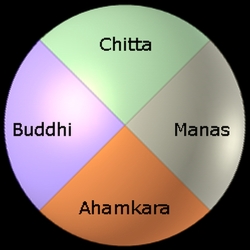Search your article
Chitta
Chitta
Chitta (Sanskrit: “memory”;) — derived from the root chit, “to be conscious”. Chitta is the Subconscious mind. It is the mind-stuff. It is the store-house of memory. Samskaras or impressions of actions are imbedded here. It is one of the four parts of Antakarana.
Chitta is the memory bank, which stores impressions and experiences, and while it can be very useful, chitta can also cause difficulties if its functioning is not coordinated with the others. If Chitta is not coordinated with the other functions of mind, then the thousands, millions, or countless impressions in this bed of the lake of mind start to stir and arise. It is as if these many latent impressions, coming to life are all competing for the attention of Manas to carry out their wants in the external world. In the absence of a clear Buddhi, the competing voices of Chitta often drive manas to take actions in the world that are really not so useful.
A good way to cultivate the witnessing of Chitta is to simply be aware of the streams of thoughts, emotions, images, and impressions that arise in front of Manas (on which Manas may or may not act). Notice how the stream of thoughts comes from somewhere, and then recedes back into that same place. This place is Chitta.
The Five aspects of the Chitta
Jagrat chitta (conscious mind; “wakeful consciousness”). The ordinary, waking, thinking state of mind in which the majority of people function most of the day.
Samskara chitta (subconscious mind; “impression mind”). The part of mind “beneath” the conscious mind, the storehouse or recorder of all experience (whether remembered consciously or not) – the holder of past impressions, reactions and desires. Also, the seat of involuntary physiological processes.
Vasana chitta (subsubconscious mind; “mind of subliminal traits”). The area of the subconscious mind formed when two thoughts or experiences of the same rate of intensity are sent into the subconscious at different times and, intermingling, give rise to a new and totally different rate of vibration. This subconscious formation later causes the external mind to react to situations according to these accumulated vibrations, be they positive, negative or mixed.
Karana chitta (superconscious mind). The mind of light, the all-knowing intelligence of the soul. The psychological term is turiya, “the fourth,” meaning the condition beyond the states of jagrat (wakefulness) , svapna (dream), and sushupti (deep sleep). At its deepest level, the superconscious is parashakti, or satchidananda, the Divine Mind of God Siva. In Sanskrit, there are numerous terms for the various levels and states of superconsciousness. Specific superconscious states such as: vishvachaitanya (“universal consciousness”), advaita chaitanya (“nondual consciousness”), adhyatma chetana (“spiritual consciousness”).
Anukarana chitta (subsuperconscious mind). The superconscious mind working through the conscious and subconscious states, which brings forth intuition, clarity and insight.
References:
[x]. Vedic Knowledge Wiki, accessed April 2020. [x]. Patanjali’s Yoga Sutras by Swami Jnaneshvara – Commentary and Translation. [x]. The Path of Consciousness. Chakras, meditation and Kundalini-Yoga by Vishwaguru Mahamandaleshwar Paramhans Swami Maheshwarananda.
